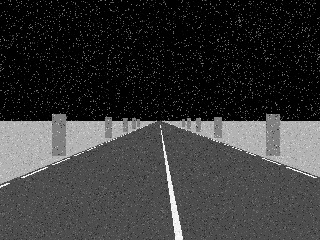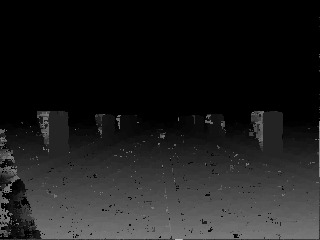Second order Markov random field is dedicated to models scenes composed by plan, which is good for urban scenes for example. Maximizing a MRF energy can be formulated as minimizing a function. It is known that it is not possible to find which set of label minimize the energy related to a second order MRF. To tackle this problem, the fusion move approach can be used. This method, based on the quadratic pseudo boolean optimization, takes two set of labels and finds the combination of labels which minimize the global MRF energy.
Example : fusion move
This example shows a fusion move between two depth maps. First line: two synthetic stereo pairs. Second line: first, a depth map resulting from a local window matching approach. The second by fitting the main plan of the scene. The last column shows the set of disparity which is computed by the fusion move. The depth from the local windows approach are kept in front-parallel objects. The road area is selected from the road plan.





References
References:
- For more information about on fusion move approach :
- Victor Lempitsky, Carsten Rother, Stefan Roth, Andrew Blake, "Fusion Moves for Markov Random Field Optimization," IEEE Transactions on Pattern Analysis and Machine Intelligence, vol. 32, no. 8, pp. 1392-1405, August, 2010
- Code:
- On this page, Vladimir Kolmogorov proposes a fast C++ application for solving QPBO problems. To handle high order clique energy, see the high order clique reduction implementation by Ishikawa here which is an interface of the previous code.